The Razer Blade Stealth Review: Razer Takes On The Ultrabook
by Brett Howse on March 29, 2016 8:00 AM EST- Posted in
- Laptops
- Razer
- Skylake
- Razer Blade Stealth
- eGFX
- Razer Core
- Skylake-U
GPU Performance
The Core i7-6500U features an Intel HD 520 graphics processor, which is a 24 execution unit (EU) configuration of Intel’s Gen 9 graphics. Intel has been focusing on graphics performance quite a bit over the last several generations, and the integrated solutions are now fairly capable. Intel also has the Iris graphics, which is a 48 EU version of this GPU and it also includes eDRAM. With Razer’s gaming pedigree it would have been nice to see this as an option on the higher model unit, but likely due to pricing and availability of the Iris parts, they have elected to stick with the standard Ultrabook part, and supplement it with an optional external graphics dock in the Razer Core. As much as this isn’t a gaming device, the addition of Iris graphics would likely have a significant impact on its capabilities, but for normal desktop tasks and light gaming, the HD 520 should do the trick.
3DMark
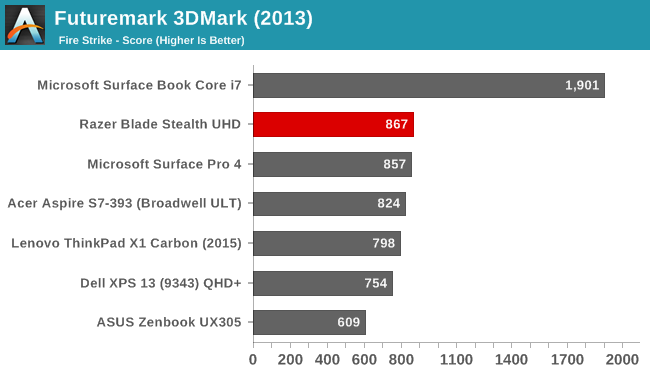
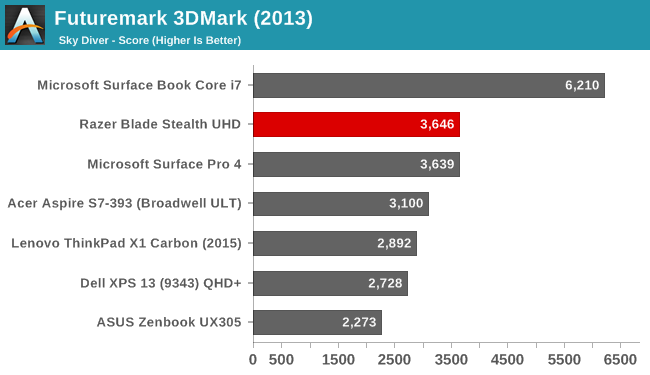
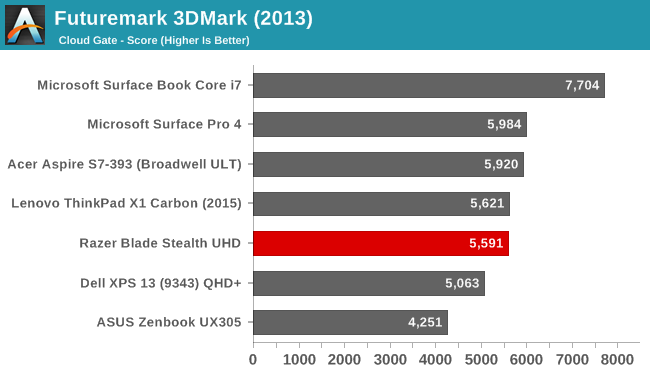

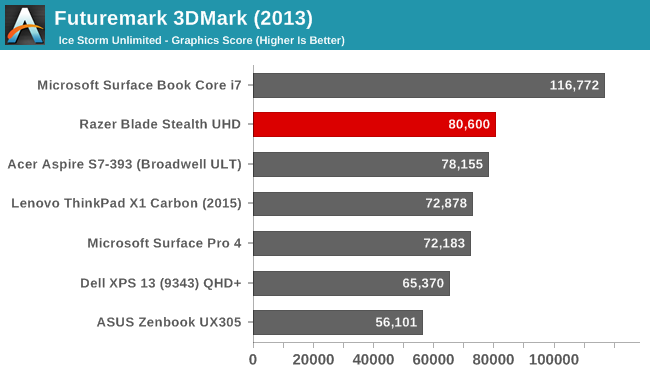
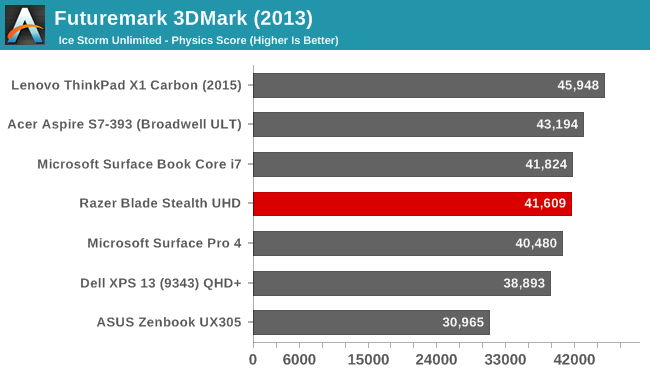
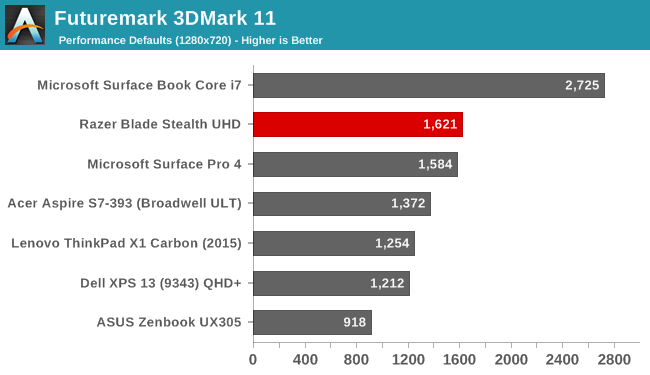
Futuremark’s 3DMark features a set of tests which ramp up in difficultly from Ice Storm Unlimited, which is basically a smartphone class test, up to Fire Strike which can be punishing even on laptops with high end GPUs. The Razer Blade Stealth falls in line with the other systems that leverage HD 520 graphics, but is a long way off of the Surface Book Core i7 with its GT 940M graphics card.
GFXBench
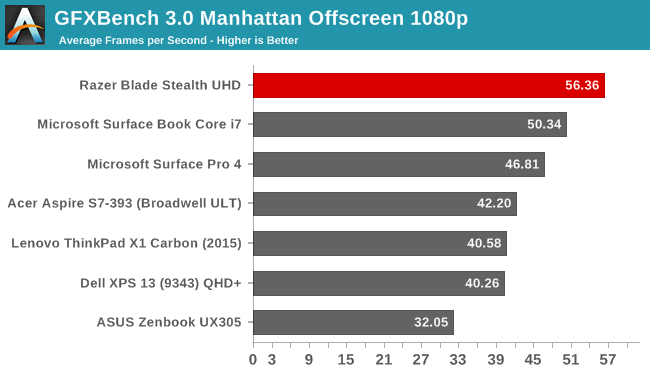
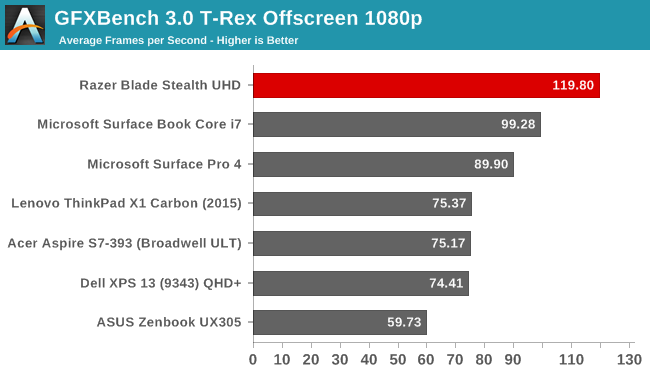
GFXBench has been updated to version 4 on Windows, giving us some new tests to work with. Once we have enough results for a comparison, the new tests will be included as well, but for now we can look at Manhattan and T-Rex. T-Rex is quite a bit lighter of a workload, and the Stealth has no issues running it at 1080p, and the results on Manhattan are decent as well.
Dota 2



Valve’s free to play online multiplayer arena game is a light enough test that it is suitable for devices with integrated graphics. Running at the maximum settings at 1080p can still be a bit too demanding, but our test run on this game is a very difficult section for the GPU so these results should be near the worst case for the graphics processor. Once again the Stealth is no match for the discrete graphics in the Surface Book Core i7, but it holds its own against the other integrated solutions. It would be really interesting to see this with Iris graphics though, but that will have to be another day.
Graphics Conclusion
The Razer Blade Stealth is not a gaming laptop, despite it being sold by a company that has focused on gaming for its entire existence. That is a bit odd, to be honest, but I can see where they were going on price and accept the choice of processor on that basis. The Core i7 version of the HD 520 has a slightly higher frequency on the GPU, which adds a tiny bit more performance over the Core i5, and of course anything that is getting to be CPU limited will struggle less with the i7, but overall the results are pretty much in-line with the other integrated solutions that we’ve tested.
Storage
The age of PCIe based storage is definitely upon us, with most of the new products this year featuring PCIe 3.0 x4 NVMe solutions, and Razer is no exception. They, like most OEMs this year, have gone with the Samsung PM951 as the drive of choice. This is a TLC based drive, and it tends to suffer on write speeds compared to the MLC SM951 version. Read speeds, especially sequential, are very good though. Hopefully we’ll start to see this supplanted by the PM961 which was just announced and which promises better performance, but it would seem Samsung has the lion’s share of the OEM drive market with the PM951.
Razer sent us both the QHD version with a 256 GB drive and the UHD version with the 512 GB drive, so we can see how much the added NAND parallelization adds to the performance.
The 512 GB model has enough NAND that the write speeds are still very good, but you can see the 256 GB version is quite a bit slower, not that 300 MB/s is really slow, but compared to the performance of the MLC version, it is down quite a bit. The 128 GB model is going to likely be closer to 150 MB/s, which is getting into desktop hard drive speeds. It’s great to see the move to PCIe storage, but unfortunately for now everyone seems to be using the TLC drive from Samsung.



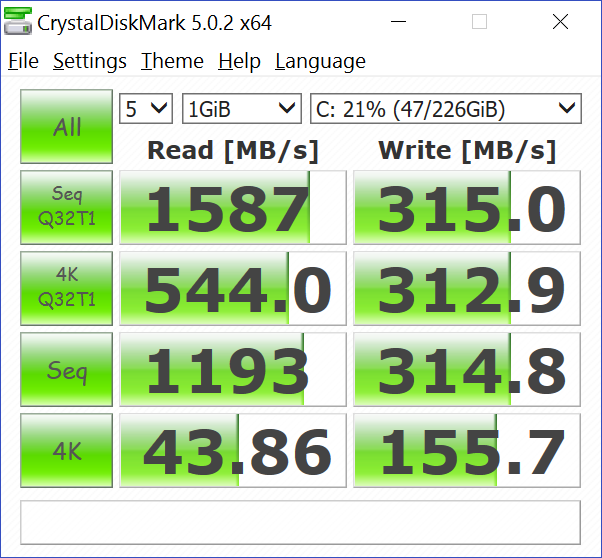








66 Comments
View All Comments
forgot2yield28 - Thursday, March 31, 2016 - link
Won't benefit the end user? Are you kidding? If you do any kind of work viewing fine vector images, such as architectural displays, a high DPI display is a godsend. For productivity software, if you have good eyesight and don't mind shrunken UI elements, you fit your work on more of the screen. It's obviously a tradeoff against battery life, but it's a tradeoff some would gladly make. It's simply not true to state there are zero use cases where a high DPI display provides a tangible benefit.niva - Friday, April 1, 2016 - link
You can disagree all you want, but anything below 1080p should be immediately disqualified from being purchased 5 years ago. An argument about 1080p for the sake of efficiency can be made, but discouraging companies from adopting higher resolution standards is just wrong. The UHD display can be ran as a 1080 for performance purposes.moozooh - Saturday, April 2, 2016 - link
> An Intel GPU in a 12.5 inch laptop display that is unable to drive games at much lower resolutions should be paired with a 1366x768 panel of decent quality with good viewing angles.That is just silly. Gaming performance is never a goal with laptops of this form-factor, not even a secondary one. If you're looking for any kind of decent gaming performance you shouldn't be considering an Ultrabook at all. Their primary task is the ability to handle large amounts of text, non-computanionally-intensive media work, and internet browsing/media consumption on-the-go for as long as possible without having to be plugged in. The difference between a 120 dpi panel and a 190+ dpi panel when working with text or photos is MASSIVE. They aren't even comparable, not if you value your eyesight and comfort at all. Had you experienced that you would never write the nonsense about 768p panels.
deeps6x - Wednesday, April 6, 2016 - link
Which is why they should have had a 1080P option with a nice Matte IPS screen. 13.3", not the micro size they went with. It fits. Use it Razor. You build this fine ass machine then gimp it with the large bezels. If Dell can do it you can do it as well, if not better.Why 1080P? Because it uses less power than 3k or 4k, and extends battery life. Why matte screen? Because touch is Intel forced cow poop, and I like to be able to use my laptops with windows behind me. Or even outside. I don't know what kind of profit Intel makes by insisting touch screens are part of the 'Ultrabook' spec, but it is one of their dumbest ideas ever. Touch on a tablet? Of course. Touch on a laptop? Useless.
jlabelle - Thursday, April 28, 2016 - link
- Higher resolution displays, while nice looking, offer little to no added functionality after reaching the point -So...it does !
And let's be honest, we are still far from smartphone resolution. I am not pushing for 4K display on a 12" screen but there is a CLEAR difference between 768p and QHD on such size.
- after reaching the point where it becomes necessary to scale the interface in order to retain visibility of objects displayed in it -
Which is not a issue per see. Windows Store applications and UI just scaled perfectly. It is old legacy software that needs to be adapted for that so indeed, it is a good thing to evolve in this direction to force the software manufacturer to make their homework as high DPI support exists on Windows since more than 7 years.
- Anything more than that won't benefit the end user regardless of how much they think they need more pixels.-
It does. What does NOT is the aRGB screen, which, as explained, for most of the operation is detrimental to the user experience.
mikesackett.85 - Thursday, March 31, 2016 - link
768 is awful, 1080p should be the minimum. Having been spoiled by nice high DPI screens (1600-1700p) I'll never go back to anything less than FHD. For me the QHD model hits the sweet spot at $999.99, for that you get an i7, 8GB Ram, 128GB SSD, and QHD touchscreen, which is higher specs than the similarly priced XPS 13 (i5, 1080p, 8GB RAM, 128GB SSD, non-touch) and a similar specced MBP is $1299. This laptop also has the added bonus of having a thunderbolt connected dGPU which none of the other options have (Though the Razer dock should work on other pc's with thunderbolt ports, including the Dell XPS 13). This laptop has the ability to serve both as a road warrior and in-home gaming machine, for that I feel it is absolutely worth the price of admission.Kristian Vättö - Tuesday, March 29, 2016 - link
I agree. The battery life is a big drawback considering that the competitors offer nearly twice the battery life.A part of my wonders why won't Razer offer a model for the normal consumer. Kill the fancy keyboard backlight and offer i3 and i5 CPUs, and the Stealth could be very competitive against the likes of Dell and ASUS. I know Razer is all about gamers, but the Stealth looks like a very solid machine and given Razer's higher-end brand status and quality I'm sure they could reach a wider audience with just a few small tweaks.
zeroqw - Tuesday, March 29, 2016 - link
Exactly. I have been monitoring the ultrabook market for 2 years and to be honest this laptop could have been a big hit with real battery life. It feels like all the ultrabook laptops got some smaller or bigger drawbacks and you just cant get what you pay for. I just hope they consider moving closer to a wider audience in the future.nerd1 - Tuesday, March 29, 2016 - link
They can provide FHD (matte) screen with i5 version at $799, which should last twice longer than this.ImSpartacus - Tuesday, March 29, 2016 - link
Since at first glance, it appears that Razer is emulating parts of Apple's strategy, I would guess that Razer is ensuring that every modern system in the Razer "ecosystem" can have a satisfactory experience with their Core.The Blade 14 & 17 are both easily up for the task. And Razer at least attempted to ensure that every Stealth will be a good match for the Core. However, if they put a weaker 15W CPU in there, then it might not perform as well with the Core.
Is that the right thing to do? Objectively no, but I wonder if that kinda of Apple-esque way of thinking of part of the reason why the Blade laptops seem to be so cool in the first place. You take the good with the bad, I guess.